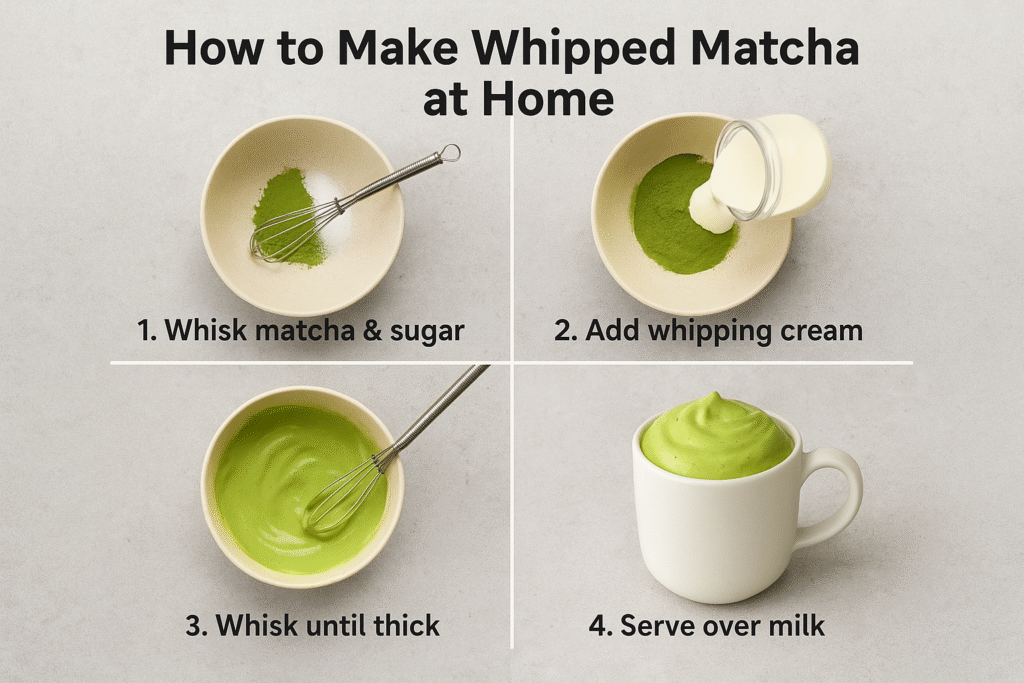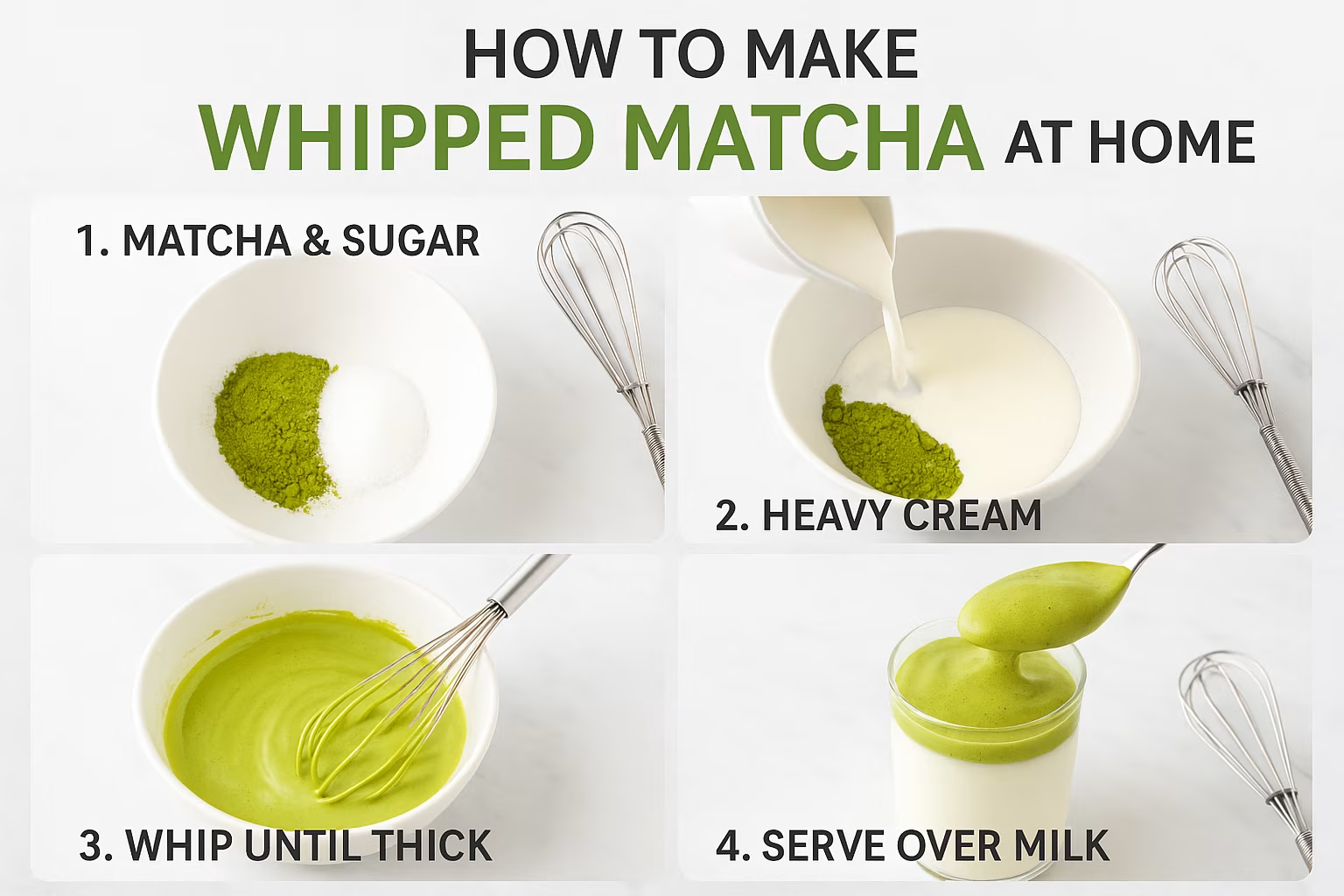Craving a matcha fix? Learn how to make whipped matcha at home that’s creamier, healthier, and tastier than Starbucks! Our step-by-step recipe, expert tips, and barista secrets will elevate your homemade matcha game to the next level.
Why Everyone’s Obsessed with Whipped Matcha
In recent years, the matcha craze has spread like wildfire across cafes, social media feeds, and kitchen countertops around the world. From the vibrant streets of Kyoto to the sleek countertops of modern minimalist kitchens in New York or Seoul, matcha green tea has become more than just a drink — it’s a statement of health, culture, and style.
But what has truly taken this trend to a frothy new level is the emergence of whipped matcha — a delightful and creamy twist on the classic beverage. Born in the wake of the dalgona coffee boom during the 2020 lockdowns, whipped matcha has become the darling of both the health-conscious and the Instagram-savvy. According to Google Trends, search interest for “whipped matcha” saw a 400% spike globally between 2020 and 2023. On TikTok, the hashtag #whippedmatcha has racked up over 50 million views.
So why is this green elixir so irresistible?
It’s visually stunning. That bright jade green whip on top of pastel plant-based milk is undeniably aesthetic.
It’s packed with antioxidants. Unlike coffee, matcha delivers caffeine without the crash, thanks to L-theanine.
It’s endlessly customizable. Vegan, keto, oat milk, sweetened with honey or monk fruit — your cup, your rules.
In short, whipped matcha blends tradition, wellness, and modern flair in one delicious ritual. And here’s the exciting part: you don’t need Starbucks (or a barista) to enjoy the perfect whipped matcha. In fact, your own kitchen might just be the best café in town.
See more: How to Make a Creamy Oat Milk Latte at Home
How to Make Whipped Matcha at Home (Better Than Starbucks!)

Let’s break it down and show you how to make the creamiest, fluffiest whipped matcha latte in your own home — using real ingredients, without added syrups, and tailored to your taste. Whether you’re a busy professional, a wellness guru, or simply a tea lover, this DIY matcha recipe will elevate your daily ritual.
Ingredients You’ll Need
The beauty of homemade whipped matcha is the simplicity of the ingredients. Here’s what you’ll need:
| Ingredient | Why It Matters |
|---|---|
| High-quality matcha powder | Use ceremonial-grade for a smoother taste and vibrant color. |
| Hot water (not boiling) | Around 80°C (175°F) — too hot and your matcha turns bitter. |
| Sweetener (honey, maple syrup, monk fruit, or agave) | Adds balance and creaminess. |
| Milk of choice (oat, almond, dairy, coconut) | Adds body and flavor contrast. |
| Optional: Vanilla extract, pink salt, collagen powder | For enhanced flavor and health benefits. |
Step-by-Step Instructions
Here’s how to whip your matcha to perfection — no barista training required.
Sift 1–2 teaspoons of matcha powder into a chilled mixing bowl.
Add 2–3 tablespoons of hot water (not boiling). Whisk with a bamboo chasen (traditional matcha whisk) or milk frother until fully dissolved and slightly foamy.
Add 1 tablespoon of sweetener of your choice and continue whisking. The mixture should start to thicken.
Using a hand frother or electric mixer, whip the mixture until soft peaks form — about 2–3 minutes.
In a tall glass, pour in your milk (cold or hot). Top it off with the whipped matcha.
Admire, snap a photo, and stir before drinking. Or drink as-is for the classic “layered” matcha effect.
Pro Tips to Perfect the Texture and Taste
Making whipped matcha at home is as much art as science. Here are expert tips from baristas, nutritionists, and Japanese tea sommeliers:
Use a chilled metal bowl to help stabilize the foam.
Adjust matcha-to-water ratio: Less water makes thicker foam.
Whisk in “W” motions, not circles — this introduces more air.
For extra volume, add a pinch of salt to the mix.
Want café-style sweetness? Try vanilla bean paste with maple syrup.
Is Homemade Matcha Really Healthier Than Starbucks?
Nutritional Breakdown: Homemade vs. Starbucks
Let’s compare a Starbucks Matcha Latte (grande, with 2% milk) to a homemade whipped matcha with oat milk and honey.
| Starbucks | Homemade Whipped Matcha | |
|---|---|---|
| Calories | 240–320 | ~100–180 (depends on milk & sweetener) |
| Sugar | 28g–40g | 6g–12g |
| Matcha Content | ~1.5 tsp (with additives) | Pure matcha powder (ceremonial-grade) |
| Additives & Syrups | Yes | No (unless added by choice) |
| Customizable? | Limited | Fully |
Barista-Level Secrets for a Fluffy, Creamy Whip
Want that Starbucks-level froth, but better? Here’s how to get it at home.
Whipping Tools: Frother vs Hand Whisk vs Electric Mixer
| Tool | Time to Whip | Texture Quality | Ease of Use |
|---|---|---|---|
| Electric Mixer | 1–2 minutes | Super frothy, stiff peaks | Very easy |
| Milk Frother | 2–3 minutes | Light foam, smooth | Very easy |
| Bamboo Chasen Whisk | 3–4 minutes | Traditional, silky | Moderate (manual) |
| Balloon Whisk | 4–5 minutes | Good volume | Labor-intensive |
Creative Twists on Classic Whipped Matcha
One of the most exciting things about making whipped matcha at home is the freedom to experiment with different flavor profiles, ingredients, and textures. At Lyoncafe, where we’ve been crafting artisan matcha drinks for over a decade (learn more at mtnlyoncafe.com), we’ve seen hundreds of innovative variations — from the wildly creative to the timeless classics. Below are some of our favorite matcha creations, each tested and perfected in real café environments.
Whipped Matcha with Oat Milk or Coconut Cream
Plant-based options aren’t just for vegans. These alternatives add unique textures and undertones:
Oat Milk: Naturally sweet, creamy, and perfect for frothy matcha. Popular in Nordic countries for its sustainability and flavor.
Coconut Cream: Offers a luxurious tropical aroma and a rich, silky mouthfeel. Pro tip: Chill coconut cream before whipping for extra stiffness.
Cashew Milk: A lesser-known alternative, but incredibly smooth and slightly nutty — pairs beautifully with ceremonial matcha.
Iced Whipped Matcha, Strawberry Matcha, and More
Want to take it a step further? Try these seasonal and fun variations to upgrade your cup:
Iced Strawberry Whipped Matcha: Layer fresh strawberry puree at the bottom of your glass, followed by oat milk, and top with whipped matcha. Stunning and delicious.
Mint Matcha Fizz: Add a splash of soda water and crushed mint leaves under the milk for a sparkling twist.
Vanilla Rose Whipped Matcha: Infuse your whip with rose water and vanilla for a floral, elegant take on your daily green tea.
Pumpkin Spice Matcha: A fall favorite. Mix cinnamon, nutmeg, and pumpkin puree into the whip for cozy café vibes at home.
“Seasonal creativity turns a cup of matcha into an experience. Don’t be afraid to think like a mixologist.” – Lyoncafe Recipe Development Team
Common Mistakes When Making Whipped Matcha (And How to Fix Them)
Let’s face it — not every first attempt is café-quality. But that’s okay. Many home brewers (even some baristas-in-training) make common errors. At Lyoncafe, we’ve trained hundreds of baristas and tested dozens of whipping methods. Here’s what we’ve learned — and how you can elevate your matcha game instantly.
Too Runny? Too Bitter? Too Lumpy? Here’s Why
| Issue | Likely Cause | Quick Fix |
|---|---|---|
| Whip is too runny | Too much water or not enough mixing time | Use less water, whip longer or chill your bowl |
| Matcha tastes bitter | Water too hot or low-quality matcha | Keep water below 80°C, upgrade to ceremonial grade |
| Texture is lumpy | Skipped sifting or weak whisking technique | Always sift, and whisk in rapid zig-zag motion |
| Whip won’t form peaks | Wrong tool or incorrect ratio of ingredients | Use a milk frother or electric mixer with less liquid |
Frequently Asked Questions (FAQs)
Still curious? You’re not alone. These are the most common questions our café patrons and online learners ask about whipped matcha:
Q: Can I use cold water instead of hot?
A: Not recommended. Hot (but not boiling) water is essential to activate the flavor compounds and dissolve the powder fully.
Q: Do I need ceremonial-grade matcha?
A: For the best flavor and color, yes. Culinary matcha is more bitter and dull in color. Ceremonial matcha, although more expensive, delivers a richer, smoother experience.
Q: What milk works best?
A: Oat milk is the most neutral and froths beautifully. Almond milk is light and nutty. Coconut milk adds sweetness and creaminess. Try them all to find your favorite.
Q: Is matcha caffeinated?
A: Yes, but it contains L-theanine, which slows the release of caffeine, promoting calm alertness rather than jitters.
Q: How long can whipped matcha last?
A: Best consumed fresh. However, you can refrigerate whipped matcha for up to 24 hours. Whip again briefly before serving.
Final Thoughts: Why Homemade Whipped Matcha Wins Every Time
If you’ve made it this far, you’re not just a reader — you’re on your way to becoming a matcha artisan. And here’s the truth: making whipped matcha at home isn’t just about the drink. It’s about reclaiming your ritual, understanding your ingredients, and creating something that’s authentic, healthy, and yours.
With rising café prices, inconsistent quality, and mass-produced ingredients, the homemade route offers total control and maximum joy. Whether you’re sipping alone in the early morning light or making a double batch to impress guests, there’s something deeply personal and fulfilling about crafting your own cup.

My name is Kara Chavez, and I love coffee. I love making the best coffees – espresso, latte, macchiato. I always strive for perfection in my barista skills, and I take great pride in bringing delicious cups of coffee to my customers.
I’ve been in the coffee industry for many years, and I know everything there is to know about brewing the perfect cup of coffee. My passion for coffee shines through in every cup I make, and I hope you’ll stop by soon so I can share my love of coffee with you!

